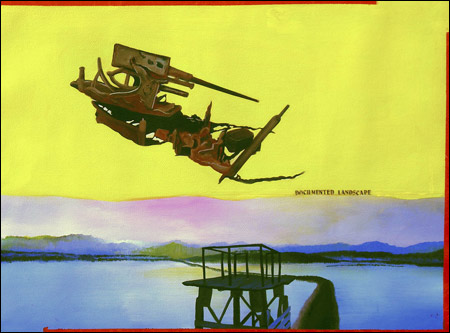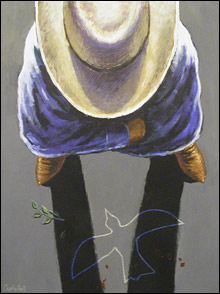There is not much dimensionality in waging war, apart from scale — killing one person at a time or many. War doesn’t express itself subtly. Waging peace, on the other hand, takes time and finds nuanced expression, such as art. No less energy is involved, it's just that the fury is transmuted into results that don't usually draw blood.
“Waging Peace,” an exhibition of 26 artists, is being presented at the Hera Gallery (October 7 through November 11).

WAR-TORN WORLD: Murali Cheeroth’s Documented Landscape.
|
Two pieces obtain much of their effect by being physically imposing. Entang Wiharso’s Puppets 1 is an installation that contains two TV screens and dangling cut-out puppets in various states of distress: one is on fire and a punk-haired head has its ears plugged by fingers. Also drawing attention by the space they take are two more installations. Corner/Cornered, by co-curator Troy West, has statements surrounding a wooden ammunition box, out of which a shroud hangs. Susan Masket’s Living Peace Room also takes up a corner, but the space is pacified by placing chairs on a rug next to a bookshelf of activist reading material. The idea is to artlessly make being at peace art in itself.
Erminio Pinque, head of the Big Nazo performance group, has contributed the towering Military Hammer #109117, a skeletal metal-painted foam-rubber robot easily as outlandish as the defense budget. Employing humor of a snarkier sort, Charlie Hall’s acrylic painting Death of the Dove has a cowboy-hatted man standing cross-armed, and presidentially self-assured, over the sidewalk chalk outline of the peace symbol.
ADVERTISEMENT
 |
Unequal, by Italian artist Paola Di Chiara, also makes a simple statement. The names of developed countries, from Nuova Zelanda to the Stati Uniti d’America, have a pair of winning dice on top of them, while the dice on a jam-packed section (Laos, Liberia, etc.) would throw only snake eyes.

DARK SHADOW: Hall’s Death of the Dove.
|
There are several responses to the theme that come from explicitly religious sources. Vivek Vilasini’s Celestial Garment is a cross formed from photographs of 28 American soldiers who died in Iraq, their holographic surface providing an unearthly glow. The photograph God Is Not an Abstract, by Zoey Stites, shows text under a magnifying glass, the words of the title standing out from the distorted fragments at the edges. Russ Smith’s Seventy Times Seven has a stoppered bottle full of bullets, accompanied by a biblical quotation from Matthew, quoting Jesus about forgiveness.
The most effective of these works is Donald Greenhaus’s Price Tag, a black and white photograph of a corpse, a morgue ID tag affixed to a blackened big toe. His impetus opens his artist statement: “We spend $193 million a day to kill people — All in HIS name.” Co-curator Claudia Flynn’s poster, Search for Peace, has her modeling as a corpse, eyes closed and shrouded by darkness; but her hand is at her chin, as though a death mask is pondering the question at the top: “Is it only through death that we can find PEACE?”
Considering the topic under discussion, some of these works are unaccountable inclusions. Stephen Brownell’s Proxy is a painting of a skyscraper façade. Ade Tugbiyele Sedita’s Moving Mountains has two doors beautifully and imaginatively painted with a green-faced suited figure, but I couldn’t detect the slightest connection with war or peace.
Given the importance of the subject, “Waging Peace” isn’t the strongest assembly of art on the theme that we can imagine. But a few works leap out to impress us with fresh observations or visual statements, despite the unlikely vision of a lasting peace in a war-torn world. The most successful inclusions here hold up questions rather than answers and remind us that process, not necessarily progress, is all that we can control.
Perhaps the most pertinent such work in the show is the entry by John Kotula, and not just because the title is “Waging Peace.” It is an accordion book, expanded for display, presenting drawings and paintings by his art students in Honduras, where the Hera member is currently a Peace Corps volunteer. As important as peace and understanding is as a concept, it's more important to create some in the world, after all.